A Resilient Economy Spurs an Improved Housing Outlook
The U.S. economy continues to grow at a modest pace despite the varied risks that we have been monitoring this year. Continued strength in labor markets has carried through to consumer spending. The resilience of consumer spending in turn signals that business fixed investment is likely to return to positive territory in the fourth quarter. And this month brought fresh evidence that housing construction is poised to become an engine of overall economic growth again.
The breadth of positive economic signals led us to revise upward our forecast of U.S. economic growth for both 2019 and 2020. We now forecast that real gross domestic product (GDP) will grow at an annualized pace of 1.8 percent during the fourth quarter, two-tenths higher than our previous forecast, and at 2.3 percent for the whole of 2019, one-tenth higher than we previously forecast. For 2020 we now expect real GDP growth of 2.1 percent, two-tenths higher than our previous, below-trend forecast. While we have incorporated small upward adjustments into most components of our forecast, our outlook for residential fixed investment (RFI)— encompassing housing starts and other elements of the housing sector—has increased more substantially.
Most risks to our forecast remain firmly to the downside, but we believe that the probabilities associated with these risks have decreased. Trade talks appear to have produced a deal between the U.S. and China, or at least a respite from tensions. The 2019 global growth slowdown appears likely to reverse next year, and recession fears prompted by yield curve inversions and weak economic data in mid-2019 have abated to the extent that some are crediting the Federal Reserve with a "soft landing." On the other hand, the possibility of a synchronized resurgence of global growth in 2020 represents an upside risk to our forecast, especially given the concerted use of monetary stimulation in most developed countries outside the U.S.
Labor Market Supports Consumption, with Business Investment Poised to Turn Positive
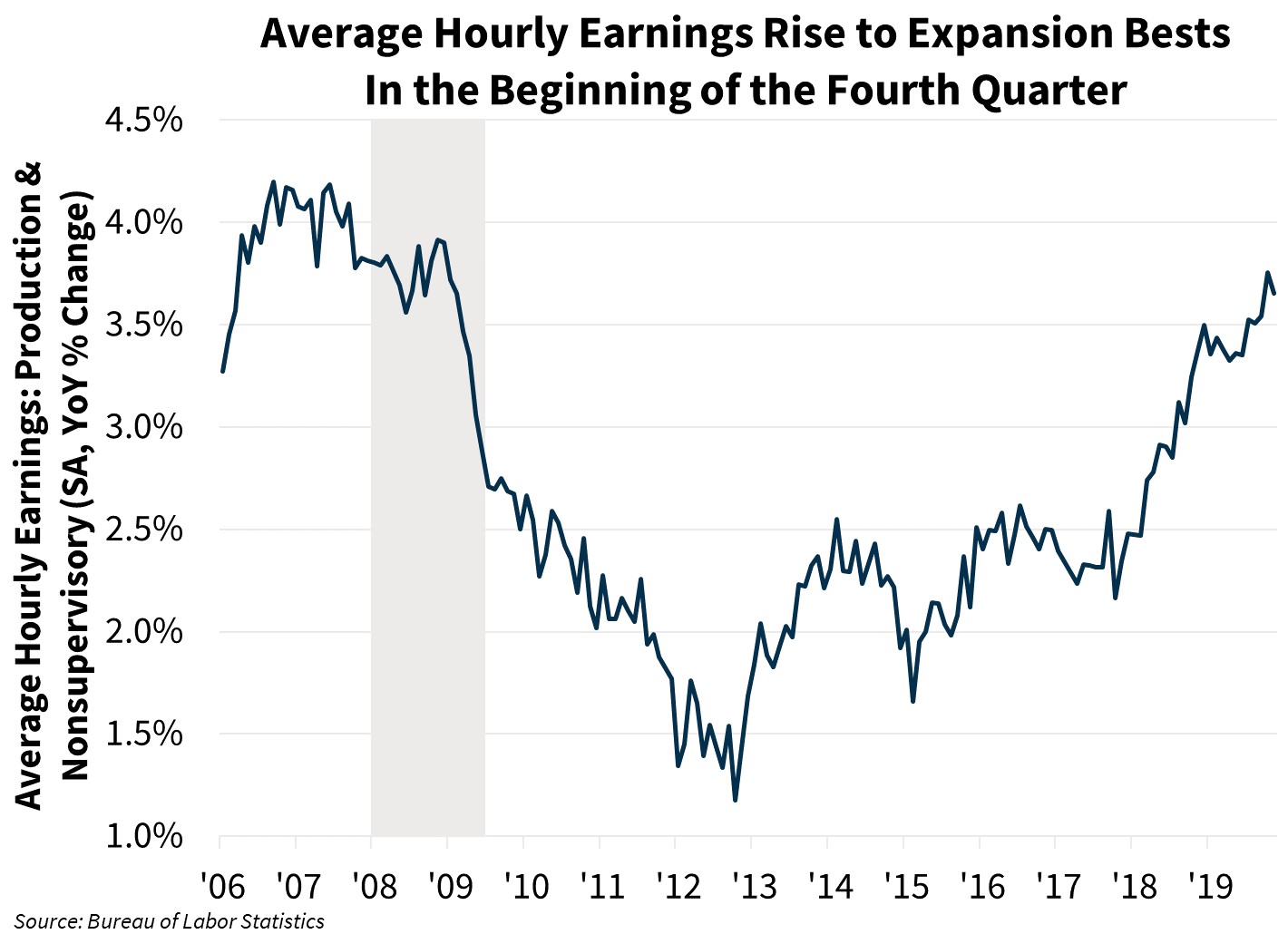
The November employment report was an ode to labor market strength. Nonfarm payrolls expanded by 266,000, surpassing even very optimistic expectations. The unemployment rate fell by another one-tenth, tying a 50-year low for the second time in three months, and the number of people who are working part-time but would prefer full-time jobs declined to near the expansion low recorded in July. Average hourly earnings grew during November by 3.1 percent year over year and have sustained a pace of 3.0 percent or better since August 2018, while production and nonsupervisory workers — whose wage growth had been worryingly stagnant during this expansion until last year — saw average hourly earnings grow at 3.7 percent year over year, a pace last seen more than 10 years ago.
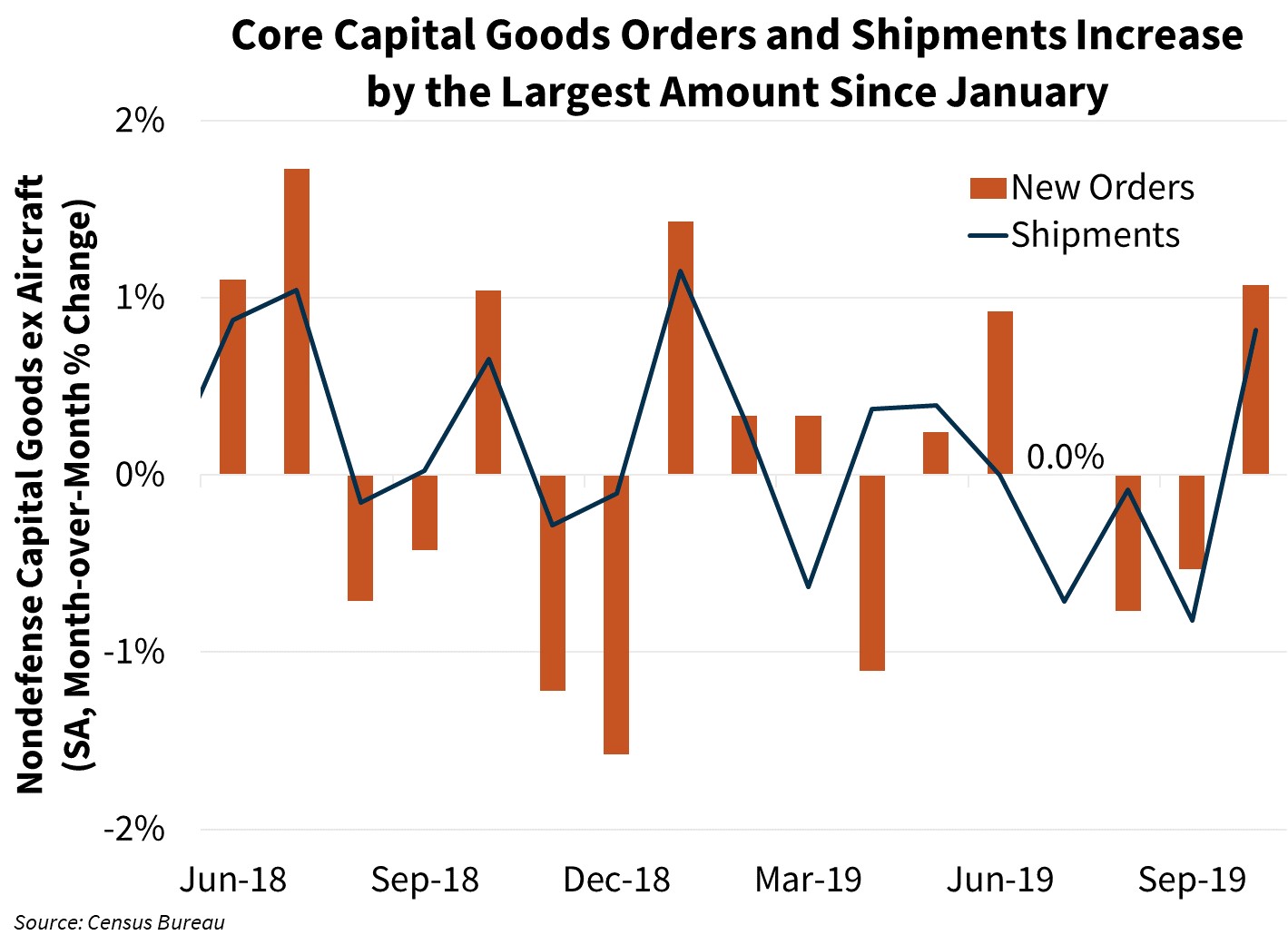
Business fixed investment (BFI) had been a significant source of weakness during the middle part of this year, dragged down by U.S.-China trade tensions, the global growth slowdown, and geopolitical concerns. Thankfully, the largest component of business investment—spending on equipment, which accounts for around 45 percent of the total—looks poised for a reversal from the 3.8 percent decline seen during the third quarter. Factory orders posted a modest gain in October, the first increase in three months, driven by rising orders for durable goods. Shipments of core capital goods (nondefense excluding aircraft), which are an input to estimate business equipment spending, posted the largest gain since the beginning of the year, while core orders, the forward-looking indicator, also posted the biggest increase since January. We expect business investment to become a positive contributor again this quarter, and while our outlook through 1Q 2020 has changed only marginally, our forecast for BFI growth during the rest of next year has increased sharply to reflect our expectation that Boeing will be able to resume deliveries of its 737 MAX aircraft in the next several months.
Interest Rates Expected to Remain in Current Range as Fed Returns to Sidelines
The Federal Open Market Committee (FOMC) cited the positive labor report and the continued strength of other incoming data in deciding at its December meeting to maintain the current federal funds target range of 1.5 to 1.75 percent and affirming that "the current stance of monetary policy is appropriate" to sustain the expansion. The increasingly high bar that the Fed has set for itself before undertaking a further change in the federal funds rate, along with our forecast of improved economic conditions, has led us to remove our previous forecast of one more rate cut in early 2020. Muted inflation remains a concern as annual growth in the PCE price deflator (the Fed's preferred inflation measure) held steady during October at 1.3 percent, tying the slowest inflation in three years and well below the Fed’s 2.0 percent target. Nevertheless, we now believe that the Fed will hold the target federal funds rate steady for all of next year, and we expect that yields will remain stable throughout our forecast horizon, with the 10-year Treasury yield remaining in the 1.8 percent range through late 2021. Mortgage rates were effectively unchanged in November, with the average rate on 30-year fixed-rate mortgages rising just 1 basis point to 3.70 percent according to Freddie Mac, and we expect them to remain within a tight range through the forecast horizon.
Large Upward Adjustments in Our Forecasts for Housing Starts and New Home Sales
The elements of our forecast related to the housing market have strengthened substantially. At the top level, we have increased our RFI forecast by 1.2 percentage points during the fourth quarter of 2019, with upward adjustments extending throughout our forecast horizon. We now expect RFI to grow at a 4.5 percent annualized rate in the fourth quarter, by 1.3 percent for the whole of 2019, and by 3.4 percent both in 2020 (up from 0.3 percent in our previous forecast) and in 2021 (up from 1.1 percent).
The improved outlook for RFI is driven primarily by significant improvements in our forecast for single-family housing starts and sales of new homes. We expect homebuilders to expand production in reaction to continued strength in labor markets and consumer spending, supportive interest rates, and waning risks of a significant near-term economic slowdown. We also expect new home sales to increase, although with a lag in the short run as builders replenish new home inventories.
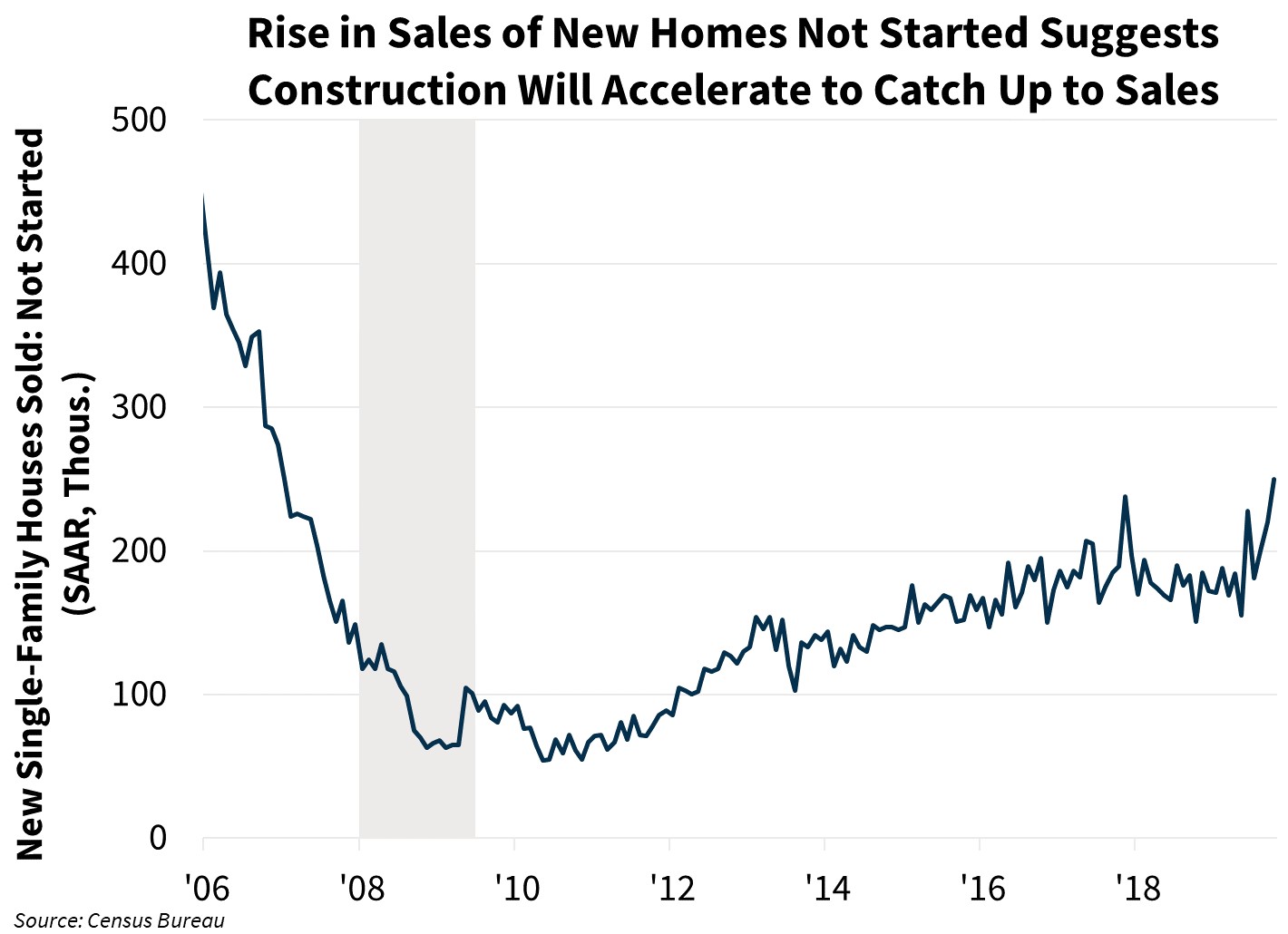
Single-family housing starts rose for the fifth consecutive month in October, and a similar growth trend in permits suggests momentum for continued growth going into the next year. Furthermore, the number of new homes sold in October that had not yet been started hit an expansion high, indicating a growing backlog of orders that will lead to construction starts. Several large publicly traded homebuilders have increased their deliveries guidance for 2020 and have shifted toward construction of more modestly priced homes, a segment of the market in high demand and short supply. The Housing Market Index published by the National Association of Home Builders continues to reflect strong homebuilder confidence, pointing toward growth in construction activities. We now expect single-family housing starts to grow by almost 10 percent during 2020 and to top one million new homes in 2021. While this pace would represent a new expansion high, it is still well below the annual peak of about 1.7 million single-family starts seen in 2005 and the 1.2 million annual pace experienced in the late 90s. It will likely take several years, even at a more robust pace, for new construction to address the existing pent-up demand for additional housing, as suggested by a still-increasing share of 25- to 34 year-olds living at home with their parents.
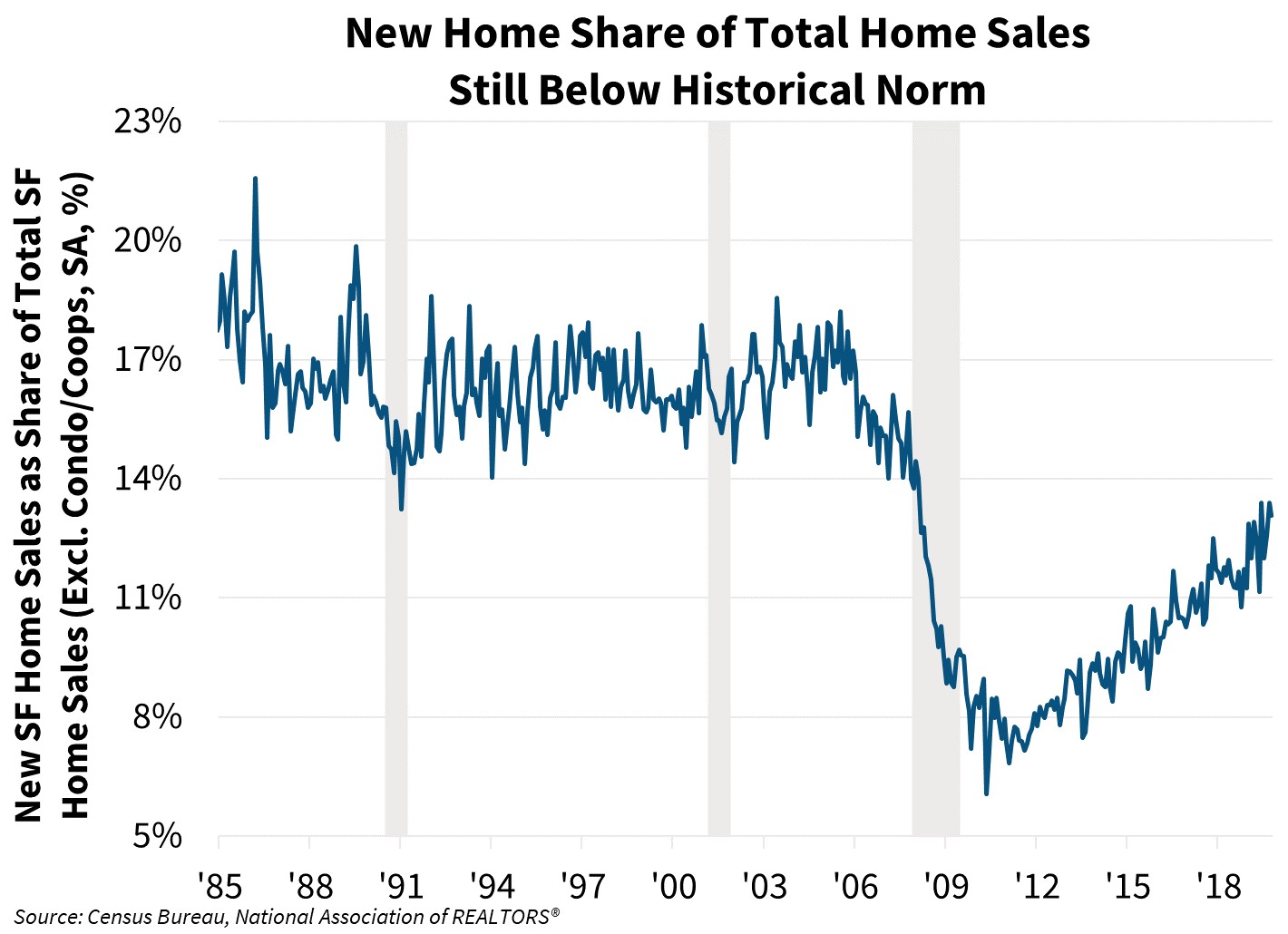
Sales of new homes fell modestly in October but remained near the expansion high recorded (after revisions) in September. While increased new home sales will coincide with the growing construction activity, we expect sales to lag in the short run as homebuilders have now worked through their previously accumulated inventories of already-started homes, meaning that starts will need to catch up to support an increased sales pace. The new home share of total sales plunged during the last recession but has been recovering since May 2010, and our outlook for stable mortgage rates and continued economic growth over the forecast horizon suggests that the new home share will continue to rise. We now expect new home sales in 2019 to show growth of 11.9 percent compared to 2018, a 2.2 percentage point increase from our previous forecast. The largest increases in our new home sales projections, though, come in the remainder of our forecast horizon with anticipated growth of 5.0 percent in 2020 (up by approximately 5.0 percentage points) and 5.5 percent in 2021 (up by 4.7 percentage points).
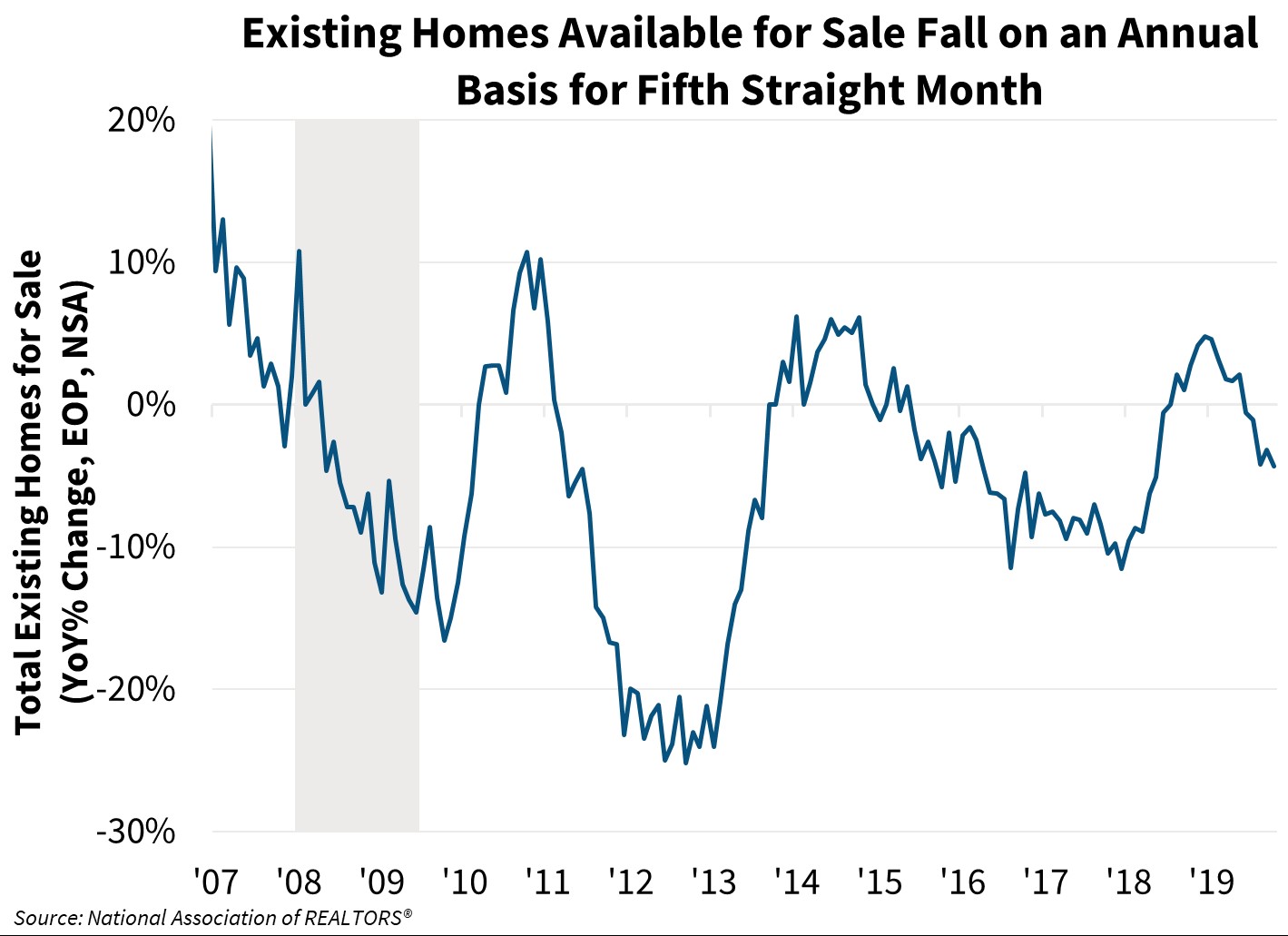
Our forecast for sales of existing homes reflects a comparatively muted improvement. Existing home sales increased in October by 1.9 percent, in line with our expectations, to a pace just shy of August’s high. While robust labor markets and favorable mortgage rates continue to support growth in housing demand, last year’s short-lived increase in homes available for sale has now reversed: Inventories as of the end of October were down by 4.3 percent from a year earlier and sat at the lowest October level since the series began in 1999. Our forecast of existing home sales during the fourth quarter remains essentially unchanged, and we continue to expect a modest decline in the pace of existing home sales through the third quarter of 2020 relative to the current quarter, but we now expect existing home sales to grow on an annualized basis by 1.5 percent in 2020 and by 0.2 percent in 2021.
Multifamily housing starts, which tend to be volatile, rose 8.2 percent in October after falling 25 percent in September; more importantly, over the last three months new permits for multifamily construction have posted among the strongest readings since the past recession. We made a modest downward adjustment to our projection for multifamily starts in the fourth quarter and maintained our previous forecast of a slightly declining path of multifamily starts, recognizing that a recent convergence of rent appreciation and income growth rates implies some level of balance in rental property supply, but low interest rates, low vacancy rates, and an expected increase in renter household formation are likely to maintain the strong pace of multifamily construction activity. For more information on multifamily market conditions please see the December 2019 Multifamily Market Commentary.
Stronger Housing Outlook is Positive for Mortgage Market
The National Delinquency Survey published by the Mortgage Bankers Association showed a decline in the delinquency rate for mortgage loans on one-to-four-unit properties in the third quarter to the lowest level since Q1 1995, while the rate of serious delinquencies (loans at least 90 days past due or in process of foreclosure) ticked down to its lowest level since Q3 2000. Delinquency rates at cyclical lows highlight the beneficial effects of strong growth in employment and wages and suggest that growth in mortgage markets has not come at the expense of weaker underwriting. In fact, Fannie Mae’s Mortgage Lender Sentiment Survey (MLSS) showed that a net share of depository institutions plan to tighten credit standards for all loan types in the next three months.
Tight supplies amid favorable demand factors continue to bolster home prices, providing further support to credit performance in the mortgage market. The Case-Shiller National House Price Index accelerated in September from a year earlier, reversing 17 months of deceleration, while the October reading of the CoreLogic Index also accelerated year over year. We expect the rate of house price appreciation, as measured by the FHFA purchase-only index, to remain at or above 5 percent through the second quarter of 2020 before decelerating through the remainder of our forecast horizon.
Our forecast for purchase mortgage originations in 2019 has held steady at $1.28 trillion, but the upward revision to our new home sales outlook led us to increase our forecast of 2020 purchase mortgage originations by $74 billion to $1.37 trillion, partially offsetting an anticipated decline in refinance activity. We expect total originations to show growth of 21.6 percent in 2019 to $2.15 trillion before declining by 4.8 percent in 2020 to $2.04 trillion, with the refinance share dropping from 40 percent in 2019 to 33 percent in 2020.
The MLSS also indicated that lenders are anticipating this decline in refinance volumes, with many expecting refinance demand to soften in response to stability in mortgage rates. Nevertheless, according to the MLSS, strong economic fundamentals are expected to support continued demand, particularly among purchase mortgages, with more than 40 percent of lenders reporting that profit margins in the fourth quarter would remain about the same as in the third quarter and expressing a positive view of profit margins heading into next year.
Economic & Strategic Research (ESR) Group
(Data effective through December 11, 2019)
For a snapshot of macroeconomic and housing data between the monthly forecasts, please read ESR's Economic and Housing Weekly Notes.
Data source for charts: Bureau of Labor Statistics, Census Bureau, National Association of REALTORS®, Fannie Mae ESR Group.
Opinions, analyses, estimates, forecasts and other views of Fannie Mae's Economic & Strategic Research (ESR) Group included in these materials should not be construed as indicating Fannie Mae's business prospects or expected results, are based on a number of assumptions, and are subject to change without notice. How this information affects Fannie Mae will depend on many factors. Although the ESR group bases its opinions, analyses, estimates, forecasts and other views on information it considers reliable, it does not guarantee that the information provided in these materials is accurate, current or suitable for any particular purpose. Changes in the assumptions or the information underlying these views could produce materially different results. The analyses, opinions, estimates, forecasts and other views published by the ESR group represent the views of that group as of the date indicated and do not necessarily represent the views of Fannie Mae or its management.
ESR Macroeconomic Forecast Team
- Doug Duncan, SVP and Chief Economist
- Brad Case, Director
- Nick Embrey, Economist
- Richard Goyette, Business Analyst
- Mark Palim, VP and Deputy Chief Economist
- Eric Brescia, Economist
- Rebecca Meeker, Financial Economist
